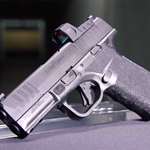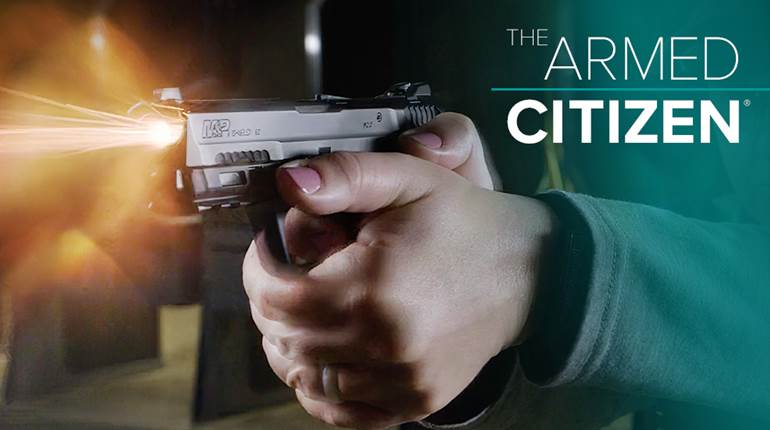
In early 1944, the U.S. Army instituted a practice of presenting general officers with a sidearm as a badge of rank. Prior to the establishment of this policy, general officers often carried various and sundry types of handguns, either the standard military sidearm of the era or non-standardized civilian handguns. For example, Gen. Douglas MacArthur sometimes carried a commercial-production .32-cal. Colt pocket pistol that was either privately purchased or received as a gift. General George S. Patton was a walking endorsement for handguns, as he is known to have carried at least eight different types at various times during his military career—including an M1911 .45 ACP, two types of Colt Pocket Models (a .32-cal. and a .380-cal.), a Colt Single Action Army revolver with ivory (not pearl!) stocks, a Smith & Wesson .357 Mag. revolver, a Colt .22 Woodsman, a .380-cal. Remington Model 51 and a .38-cal. Colt Detective Special revolver. General Dwight D. Eisenhower had a Colt .380 Pocket Model pistol that he reportedly carried in a leather holster inside his trousers held in place by a metal clip fashioned from part of a mess kit.
The pistol selected for presentation to general officers beginning in 1944 was the .380 ACP-chambered “Model M,” or more popularly, the “Pocket Model,” produced by Colt Patent Firearms Mfg. Co. The .32-cal. version of the gun was introduced in 1903, followed by the .380-cal. version in 1908. Although not official designations, the .32 ACP version is often referred to as the “Model 1903” and the .380 as the “Model 1908.” By the time production ceased in 1945, the combined total production of both types had exceeded 700,000. The reasons for the selection of the Colt Model M pistol for presentation to general officers were its ready availability, suitability for the purpose at hand and general popularity in and out of the military. The fact that the pistol was favored by three of the Army’s most noted generals may or may not have had a bearing on the decision to issue the Colt Pocket Model pistol for this purpose.
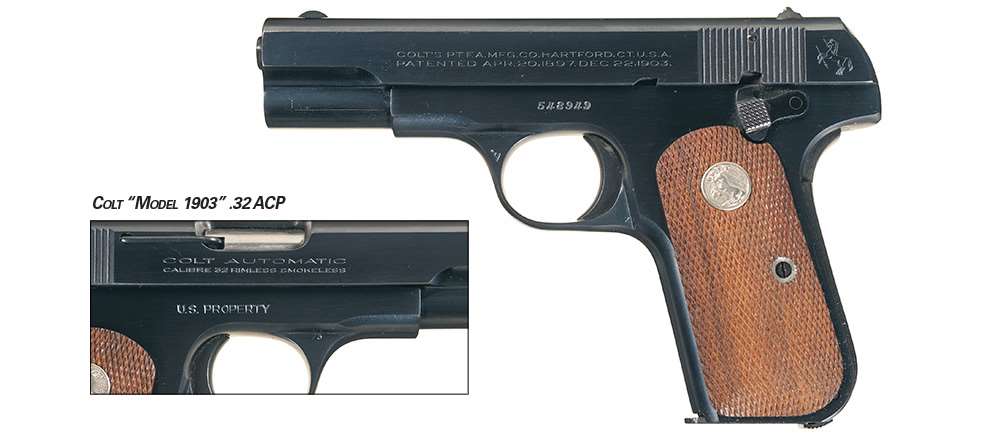
“Model 1903” Pistol
Actually, the procurement of Colt Pocket Model pistols by the American military predated the Second World War. The first recorded U.S. military purchase of the .32 Colt Model M dated back to Sept. 29, 1917, when 200 guns were shipped to the Washington Navy Yard. Little or no further government procurement occurred until early in World War II. The British government acquired approximately 7,500 .32-cal. Model M pistols during the war under the Lend-Lease Program. Many of these were utilized by the British Special Operations Executive (SOE), a group somewhat analogous to the American OSS, which provided a number of them to resistance groups in occupied Europe. The most notable use of one of these pistols was during the assassination of Reinhard Heydrich, chief of the Nazi Gestapo and one of the architects of the Holocaust.
Approximately 17,337 .32-cal. Model M pistols were purchased by the United States government in World War II between April 1941 and February 1945. Beginning in January 1942, these pistols were marked “U.S. Property” on the receiver. Some were also stamped with the Ordnance “crossed cannons” escutcheon. The guns were finished in Colt factory bluing until about October 1944. Beginning in the 562000 serial number range, the finish was changed to “Parco-Lubrite,” a phosphate finish comparable to Parkerizing.
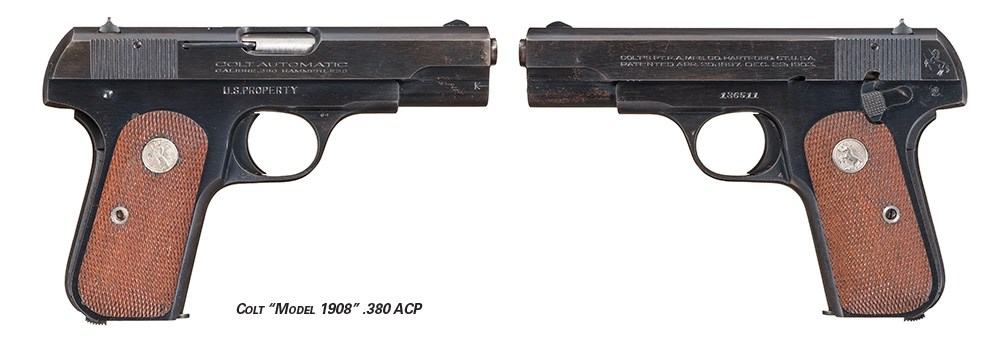
“Model 1908” Pistol
When the practice of issuing special sidearms to Army general officers was instituted, the .380 ACP “Model 1908” Colt Model M was selected for this purpose. For some reason, the .380-cal. version was acquired in far fewer numbers than the .32 ACP guns by the United States military in World War II. Records indicate that 3,113 “M1908” .380-cal. Pocket Auto Pistols were acquired by the U.S. military between March 3, 1942, and June 5, 1945. The .380 ACP pistols procured prior to early 1944 were not manufactured under government contract but were purchased either directly from Colt’s inventory or via “blanket procurement” from other civilian sources.
With very few exceptions, the .380-cal. pistols manufactured in 1944-45 were marked “U.S. Property” and some also had the Ordnance “crossed cannons” escutcheon. Unlike the Colt .32 ACP “Model 1903” Pocket Pistols manufactured under government contract, none of the .380-cal. “Model 1908s” apparently left the factory with a Parkerized-type finish, although some may have been re-finished later.
The first deliveries of the .380-caliber Model M pistol manufactured under U.S. government contract was in early 1944. As stated in the Ordnance Dept. Project Supporting Paper No. 39:
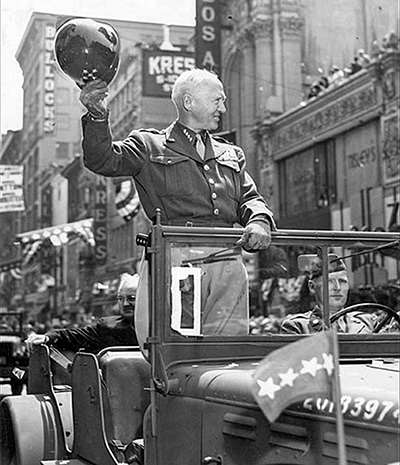
“The Colt Pocket Automatic, Caliber .380, was procured for issue to General Officers of the Army and was similarly issued by the Navy to authorized officers. Like all commercial weapons, the .380 Colt was inspected without benefit of drawings or gages in the hands of Ordnance inspectors. Weapons which functioned perfectly during Ordnance tests could not be depended upon to stand up under continued use for a normal serviceable life. After correction of defective Magazines and Ejectors, the .380 Colt performed reasonably well however, and was popular because of its light weight, small size, and neat appearance.”
Although the above-cited Ordnance Dept. document indicated that the Colt .380 pistol was “similarly issued by the Navy to authorized officers,” there was not a specific policy of issuing such arms to newly appointed “flag officers” (admirals).
In addition to receiving the Colt “Model 1908” .380 pistol, the general officer was also given a brown leather belt, holster, magazine pouch for two magazines, gold buckle and cleaning rod. After World War II, the leather goods were changed to black. However, the “official” leather holsters and belts were not available until later in the war, so many of the Colt Pocket Automatic general officers’ pistols were carried in various types of holsters. Although presented upon receiving a promotion to general, these pistols were technically “on loan” to the officer. Upon retirement, he had the option of purchasing his pistol rather than surrendering it, and many availed themselves of the opportunity to do so.
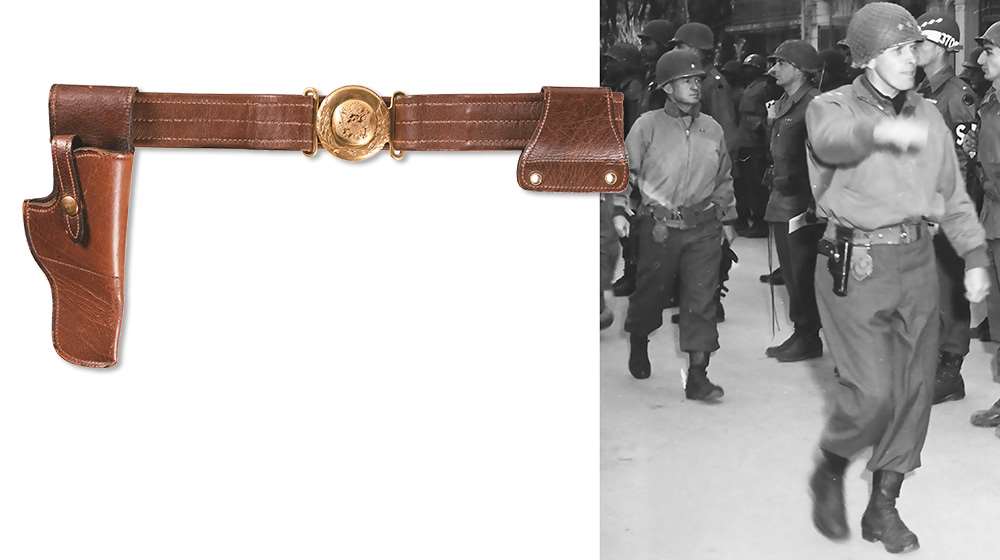
While the existence of these pistols has been well-established, there is still some uncertainty as to what prompted the formulation of the policy of presenting these pistols to general officers during World War II. Several theories were proffered by author Horace Greeley, IV, in his authoritative book The Colt General Officers’ Pistols:
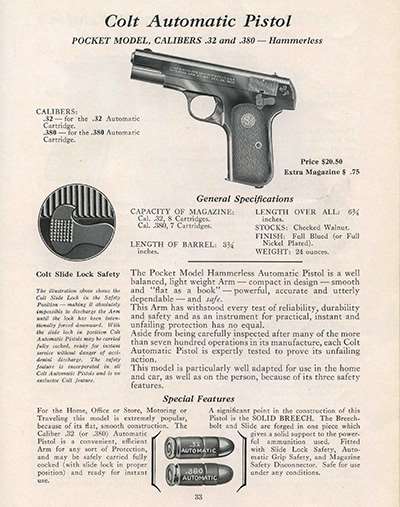
“Several explanations of the origin of this practice of issuing unique weapons are given … Some indicate that one general officer was killed [in WWII] by an enemy patrol when he tried to return to his vehicle for a weapon … thus prompting the Army to start the practice. Others believe that during World War II the necessity arose for general officers to be armed with something that would not restrict their movement in or out of jeeps, airplanes and other vehicles which were somewhat tight and at the same time provide some measure of personal defense. Another school of thought claims that the practice started in August 1944. At that time, right after the invasion of the continent of Europe, it looked as if the American Army would be victorious and a ceremonial weapon, i.e., badge of rank, would be in order for high-ranking officers … The United States Navy states that no provision for special sidearms is made for officers reaching flag rank.”
It should not be construed that all of the .380-cal. pistols procured during World War II were slated for presentation to general officers, as many were supplied to the OSS and various units of the U.S. Army and the U.S. Navy. As reported in War Dept. documents, the first .380 pistols made under government contract were actually requisitioned by the U.S. Navy.
Upon exhaustion of the .380 ACP pistols, the .32-cal. “M1903” Pocket Model was to be substituted. However, there were sufficient numbers of the “M1908” .380 pistols to supply the demand for general officers’ pistols during the war; thus, any issuance of the .32 ACP pistols to general officers occurred in the postwar period. The .380-cal. pistols were given to general officers of the Army from 1944 through 1950. Presentation of the .32-cal. pistols began in 1950 and continued through 1972.
World War II-era military-contract Colt Model M pistols, of both .32 and .380 caliber, are popular martial collectibles today. Since there were no distinguishing characteristics between the standard military pistols and those issued to general officers, some documentation is necessary to confirm whether or not a particular example falls into the latter category. Fortunately, this can be accomplished by contacting the Army Sustainment Command History Office at Rock Island Arsenal ([email protected]), which has information for most of the general officer pistols from World War II through approximately 2008. If desired, a factory letter from Colt could probably be obtained as well. Any verified example would be worth a substantial premium over a standard military-contract Colt Model M pistol in comparable condition.
Presenting general officers with a special pistol was a fitting and appropriate tribute to acknowledge their service and dedication to our country. It’s unfortunate, but the Colt Pocket Model pistols, both those presented to general officers and those issued for other purposes, are often left out of discussions regarding U.S. military arms of World War II.
General Officers’ Pistols In The Modern Era
While the World War II-production .32-cal. Colt Pocket Model pistols continued to be issued to general officers through 1972, by about 1969 there began to be a shortage of serviceable examples, and existing stocks had to be cannibalized to meet the demand. Since Colt had ceased production of the Model M pistol in 1945, it was apparent that a new type of handgun for presentation to general officers was required.
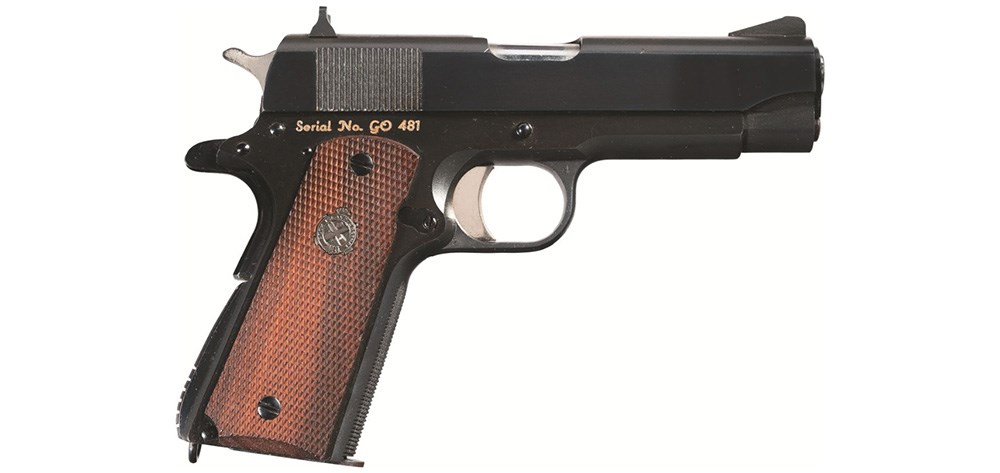
M15
Although the supply of the World War II Colt Model M pistols was rapidly becoming depleted, there were still ample stocks of M1911A1 .45 service pistols in the Army’s inventory. It was determined that a special pistol be developed for issuance to general officers. A program was instituted at Rock Island Arsenal wherein standard-issue M1911A1 .45 pistols would be modified by shortening the slide, barrel and related components, buffing off the existing markings and refinishing the gun in an attractive blued finish, except for the top of the slide, which was given a matte-black finish. The shortened barrel was chrome-plated and high-profile front and rear sights were fitted. The left side of the slide was marked “General Officer Model/RIA.” The right side of the frame was marked “Serial No. GO XXX”. Checkered walnut stocks were fitted, with the right one having an inlaid cast-metal Rock Island Arsenal insignia and the left a blank silver plate onto which the receiving officer’s name could be engraved. The general configuration of the modified pistol, designated as the “M15,” resembled the civilian Colt “Commander” pistol. Deliveries began in late September 1972 and production ceased in 1982, by which time a total of 1,004 had been issued.
After the last M15 pistol was issued, general officers were presented with standard M1911A1 pistols that had no distinguishing characteristics or special serial-number range. About 410 standard M1911A1 pistols were presented between 1982 and 1986. Undoubtedly, some officers who subsequently received such guns upon their promotion to general were a bit disappointed that the attractive and unique M15s were no longer available.
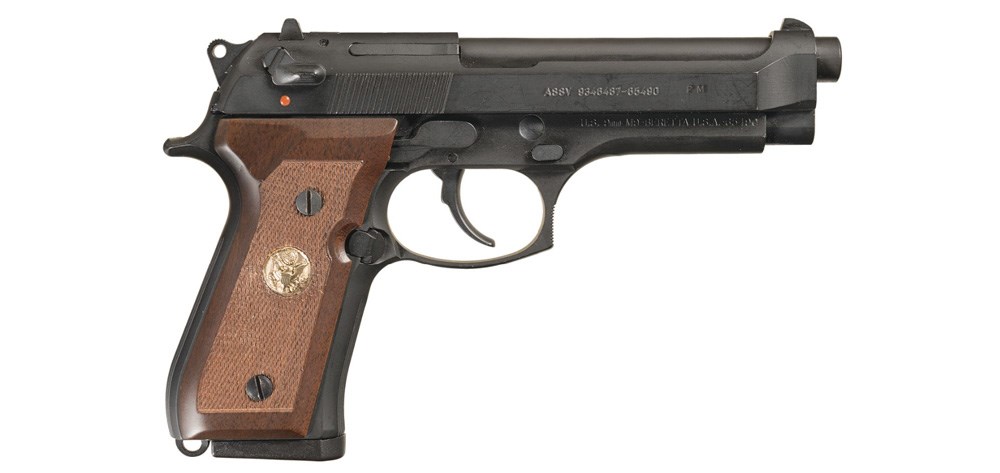
Beretta M9
In 1985, the U.S. Army adopted the Beretta M9 pistol chambered for the 9 mm Luger cartridge to replace the M1911/M1911A1 .45 pistols, variants of which had served the American military for almost three quarters of a century. Soon after procurement of the M9 began, the issuance of a slightly modified example for presentation to newly promoted Army and Air Force general officers was approved. This pistol was essentially the same as the standard M9 service handgun but had a special number with a “GO” prefix. A few have been noted with special checkered walnut stocks with a brass identification plate upon which the recipient’s name could be engraved, although many were fitted with the standard plastic stocks. A total of 555 M9 general officers’ pistols were issued from August 1986 through December 1987 when the program was discontinued.
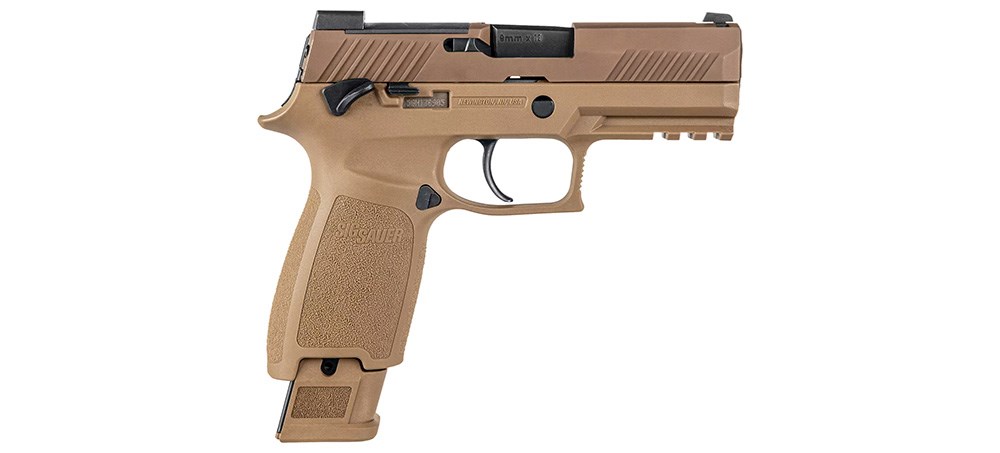
SIG Sauer M18
In 2017, the U.S. Army announced that the Beretta M9 would be replaced by the SIG Sauer M17 and M18 pistols. It was also revealed that 800 “personalized” M18 pistols, a slightly smaller version of the M17, would be earmarked for issuance to general officers. As was the case with the Beretta M9, the Officers’ Model M18 has special serial numbers with a “GO” prefix. The “personalization” of each pistol consists of a small, medium or large grip module configured to the officer’s needs upon delivery of the pistol. Thus, the practice of presenting general officers with a special pistol, which began in 1944, has continued on into the 21st century.


























